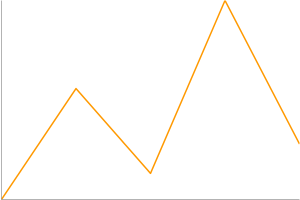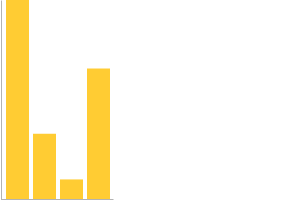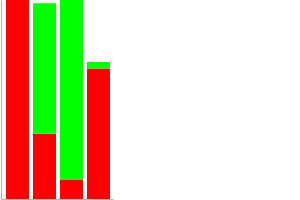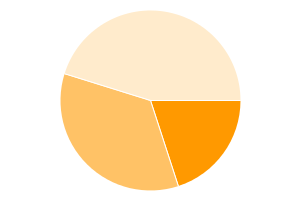CSC/ECE 517 Spring 2015 E1522 Visualization: Difference between revisions
No edit summary |
|||
| Line 208: | Line 208: | ||
==Visualization in Expertiza== | ==Visualization in Expertiza== | ||
This section describes where in Expertiza we can use these visualization to have a better user experience. | |||
The 'Review Score' view of the assignments can be enhanced using these visualization. | |||
==Reference== | ==Reference== | ||
<references/> | <references/> | ||
Revision as of 14:47, 6 April 2015
Expertiza - Visualization
Project Description
In this project, the data in Expertiza would be presented in a more convenient and instinct way.
Purpose
The purpose of this project is to add a visualization element to some of the data collected in expertiza. The aim of this is to provide a more intuitive “at-a-glance” idea of the data, some examples would be: how a student is doing on his/her assignments, or how their work compares to that of their classmates.
Overview of Approach
There are quite a few gems available to visualize data in Ruby on Rails, like Goolgecharts <ref>http://googlecharts.rubyforge.org/</ref> and GoogleVisualr <ref>http://googlevisualr.herokuapp.com/</ref>. These gems makes use of Google Visualization API and wrap it to let users write ruby codes to present nice charts in their web pages instead of using Javascript.
GoogleVisualr
GoogleVisualr is a a wrapper around the Google Chart Tools<ref>https://developers.google.com/chart/</ref> which allows users to create beautiful charts with just Ruby, instead of writing JavaScript if using the Google Chart Tools directly.
Installing
Installing GoogleVisualr is pretty simple. Just include the following gem in the Gemfile.
gem "google_visualr", "~> 2.1.0"
And in the Rails layout, load Google Ajax API in the head tag, at the very top.
<script src='http://www.google.com/jsapi'></script>;
Work Flow
- In your model or controller, write Ruby code to create your chart (e.g. Area Chart, Bar Chart, even Spark Lines etc).
# Add Column Headers
data_table.new_column('string', 'Year' )
data_table.new_column('number', 'Sales')
data_table.new_column('number', 'Expenses')
# Add Rows and Values
data_table.add_rows([
['2004', 1000, 400],
['2005', 1170, 460],
['2006', 660, 1120],
['2007', 1030, 540]
])
- Configure your chart with any of the options as listed in Google Chart Tools' API Docs.
option = { width: 400, height: 240, title: 'Company Performance' }<br/>
@chart = GoogleVisualr::Interactive::AreaChart.new(data_table, option)
- In your view, invoke a chart.to_js(div_id) method and that will magically generate and insert JavaScript into the final HTML output.
<div id='chart'></div> <%= render_chart @chart, 'chart' %>
Chart Examples
Area Chart<ref>http://googlevisualr.herokuapp.com/examples/interactive/area_chart</ref>
The following code presents the example of area chart.
# http://code.google.com/apis/chart/interactive/docs/gallery/areachart.html#Example
def area_chart
data_table = GoogleVisualr::DataTable.new
data_table.new_column('string', 'Year')
data_table.new_column('number', 'Sales')
data_table.new_column('number', 'Expenses')
data_table.add_rows( [
['2004', 1000, 400],
['2005', 1170, 460],
['2006', 660, 1120],
['2007', 1030, 540]
])
opts = { width: 400, height: 240, title: 'Company Performance', hAxis: {title: 'Year', titleTextStyle: {color: '#FF0000'}} }
@chart = GoogleVisualr::Interactive::AreaChart.new(data_table, opts)
end
The resulting chart looks like below.
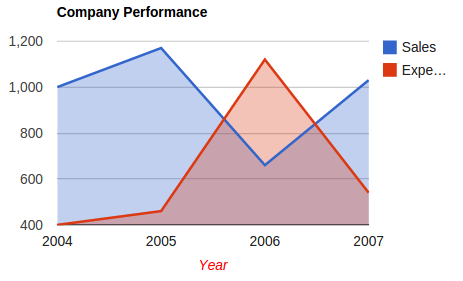
Bar Chart<ref>http://googlevisualr.herokuapp.com/examples/interactive/bar_chart</ref>
The following code presents the example of area chart.
# http://code.google.com/apis/chart/interactive/docs/gallery/barchart.html#Example
def bar_chart
data_table = GoogleVisualr::DataTable.new
data_table.new_column('string', 'Year')
data_table.new_column('number', 'Sales')
data_table.new_column('number', 'Expenses')
data_table.add_rows(4)
data_table.set_cell(0, 0, '2004')
data_table.set_cell(0, 1, 1000)
data_table.set_cell(0, 2, 400)
data_table.set_cell(1, 0, '2005')
data_table.set_cell(1, 1, 1170)
data_table.set_cell(1, 2, 460)
data_table.set_cell(2, 0, '2006')
data_table.set_cell(2, 1, 660)
data_table.set_cell(2, 2, 1120)
data_table.set_cell(3, 0, '2007')
data_table.set_cell(3, 1, 1030)
data_table.set_cell(3, 2, 540)
opts = { :width => 400, :height => 240, :title => 'Company Performance', vAxis: {title: 'Year', titleTextStyle: {color: 'red'}} }
@chart = GoogleVisualr::Interactive::BarChart.new(data_table, opts)
end
The resulting chart looks like below.
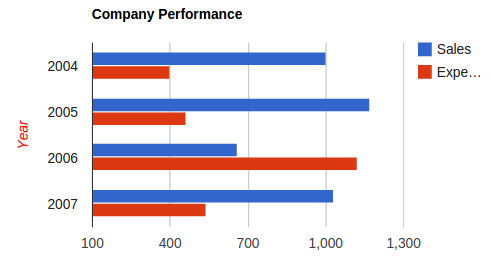
Bubble Chart<ref>http://googlevisualr.herokuapp.com/examples/interactive/bubble_chart</ref>
The following code presents the example of area chart.
# http://code.google.com/apis/chart/interactive/docs/gallery/bubblechart.html
def bubble_chart
data_table = GoogleVisualr::DataTable.new
data_table.new_column('string', 'ID')
data_table.new_column('number', 'Life Expectancy')
data_table.new_column('number', 'Fertility Rate')
data_table.new_column('string', 'Region')
data_table.new_column('number', 'Population')
data_table.add_rows( [
['CAN', 80.66, 1.67, 'North America', 33739900],
['DEU', 79.84, 1.36, 'Europe', 81902307],
['DNK', 78.6, 1.84, 'Europe', 5523095],
['EGY', 72.73, 2.78, 'Middle East', 79716203],
['GBR', 80.05, 2, 'Europe', 61801570],
['IRN', 72.49, 1.7, 'Middle East', 73137148],
['IRQ', 68.09, 4.77, 'Middle East', 31090763],
['ISR', 81.55, 2.96, 'Middle East', 7485600],
['RUS', 68.6, 1.54, 'Europe', 141850000],
['USA', 78.09, 2.05, 'North America', 307007000]
])
opts = {
:width => 800, :height => 500,
:title => 'Correlation between life expectancy, fertility rate and population of some world countries (2010)',
:hAxis => { :title => 'Life Expectancy' },
:vAxis => { :title => 'Fertility Rate' },
:bubble => { :textStyle => { :fontSize => 11 } }
}
@chart = GoogleVisualr::Interactive::BubbleChart.new(data_table, opts)
end
The resulting chart looks like below.
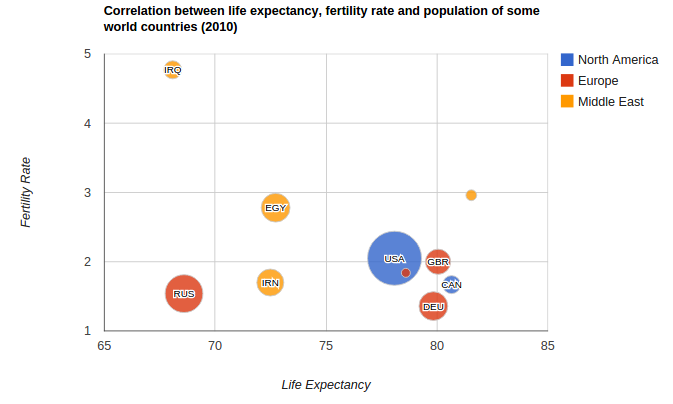
GoogleCharts
Googlecharts is a ruby gem implements a wrapper for Google Chart API. It is fully tested using RSpec.
Usage
Installing
gem install googlecharts
Example in Ruby on Rails
Controller:
@line_chart = Gchart.line(:data => [1, 2, 3, 4, 5])
View:
<%= image_tag(@line_chart) %>
Basic Usages
require ‘gchart’
Gchart.line(:size => ‘200*200’, :title => “title”, :bg => ‘efefef’, :legend => :data => [1, 2, 3, 4, 5])
Detail Usages
simple line chart:
Gchart.line(:data => [0, 40, 10, 70, 20])
bar chart:
Gchart.bar(:data => [300, 100, 30, 200])
multiple bars chart:
Gchart.bar(:data => [[300, 100, 30, 200], [100, 200, 300, 10]], :bar_colors => ['FF0000', '00FF00'])
pie chart:
Gchart.pie(:data => [20, 35, 45])
These usages come from http://googlecharts.rubyforge.org/. If you want to see more usages, go and visit this site.
Visualization in Expertiza
This section describes where in Expertiza we can use these visualization to have a better user experience. The 'Review Score' view of the assignments can be enhanced using these visualization.
Reference
<references/>
